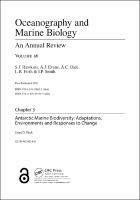Chapter 3 Antarctic Marine Biodiversity
Proposal review
Adaptations, Environments and Responses to Change
Abstract
Animals living in the Southern Ocean have evolved in a singular environment. It shares many of its attributes with the high Arctic, namely low, stable temperatures, the pervading effect of ice in its many forms and extreme seasonality of light and phytobiont productivity. Antarctica is, however, the most isolated continent on Earth and is the only one that lacks a continental shelf connection with another continent. This isolation, along with the many millions of years that these conditions have existed, has produced a fauna that is both diverse, with around 17,000 marine invertebrate species living there, and has the highest proportions of endemic species of any continent. The reasons for this are discussed. The isolation, history and unusual environmental conditions have resulted in the fauna producing a range and scale of adaptations to low temperature and seasonality that are unique. The best known such adaptations include channichthyid icefish that lack haemoglobin and transport oxygen around their bodies only in solution, or the absence, in some species, of what was only 20 years ago termed the universal heat shock response.
Keywords
oceanography; marine biology; environment; climate change; climate change impacts; Southern Ocean; high Arctic; ice; seasonality; phytobiont productivity; Antarctica; Antarctic fauna; marine invertebrate species; endemic species; low temperature adaptations; seasonality adaptions; channichthyid icefish; universal heat shock response; gametogenic cycles; vitellogenesis; microtubule assembly; locomotion; metabolic rate; whole-animal growth; embryonic development; limb regeneration; echinoderms; Southern Ocean fauna; ecophysiological adaptations; coldblooded marine speciesDOI
10.1201/9780429454455Publisher
Taylor & FrancisPublisher website
https://taylorandfrancis.com/Publication date and place
2018Imprint
CRC PressClassification
Biology, life sciences
Marine biology
Environmental science, engineering and technology


 Download
Download